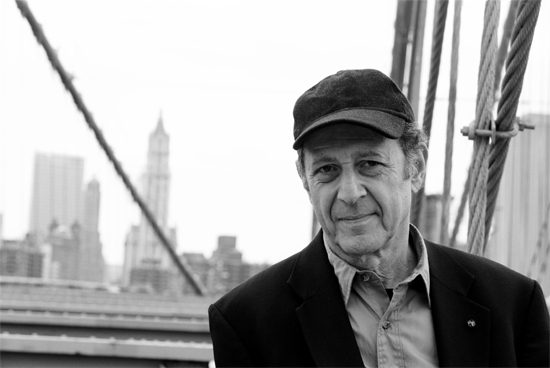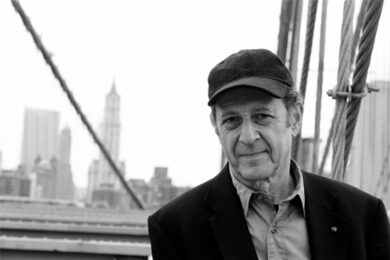Steve Reich, Steve Reich, Steve Reich: a composer whose music is inescapable. You’ve heard it, I guarantee, even if you don’t realise you have. Those glittering rhythmic loops and pulsing waves of tuned percussion have formed the backdrop to a thousand TV documentaries. Shots of little fluffy clouds drifting overhead or time-lapse footage of bustling commuters now seem to invite an immediate application of Steve Reich to the soundtrack.
Or perhaps you own a Steve Reich album? It would not be so unusual. His music has reached out to fans of contemporary classical music and beyond to fans of alternative rock, pop and dance music. He was one of the first composers of the late 20th century to effortlessly win that unfeasible holy grail sought by promoters of classical music: bringing down the average age of the audience. In fact, by the end of the 1970s, he was easily able to sell out Carnegie Hall, filling it not with the classical music cognoscenti, but with a young crowd more used to going to rock gigs.
Steve Reich’s success is based on a simple, but increasingly rare achievement. He found a ‘voice’, a uniquely identifiable sound. Like a glimpse of a film by an auteur director, just a few seconds of his music will give him away. "That’s Steve Reich!" …or is it? Hang on… it’s definitely something that sounds like Steve Reich. You see, that sound has become one of the most influential and inspiring in all the music of the last 50 years, to the point of being openly imitated, frequently.
That breadth and depth of influence will be celebrated by the Barbican this weekend with a two-day festival, Reverberations, featuring music written not only by Reich, but also by a bevy of musicians inspired by him. This includes two generations of smart, creative classical composers, such as Louis Andriessen and Julia Wolfe, beside the more unexpected presence of musicians associated with left-field pop music, such as (former Battles frontman) Tyondai Braxton, Owen Pallett and The National’s guitarist Bryce Dessner, all of whose music is somewhat infected by Reich’s sonic palette of revolving loops and luminous textures.
A (perhaps unsurprising) confession: I am pretty sure that my own involvement in music is to large extent thanks to Steve Reich. As a nerdy, ‘quirky’ child I obsessively worked my way through the collection of recordings of 20th century masterpieces at the Leicester music library. Whilst the mad, brave new soundworlds of modernist composers like Stockhausen were exciting to discover, it was Steve Reich’s music that really (to use that cringeworthy phrase) ‘spoke to me’. I remember listening to the ECM recording of Steve Reich and Musicians playing his Music for a Large Ensemble (1978) and Octet (since re-titled Eight Lines, 1979) and being astonished by that sound: an immediately comprehensible, structurally transparent yet somehow unreal flow. Those textures were entirely fresh to my ears: the dancing web of marimbas and pianos against the serenely drifting strings and the icy, ethereal vibraphone cues. It was hypnotic, fascinating, moreish.
When I was 14 I wrote him fan mail. It seems unlikely for any classical composer to receive gushing teenage praise, but that’s how much his music excited me. He was gracious enough to reply too, which was nice.
I’m obviously not alone in my enthusiasm. Besides those appearing at the Barbican, musicians who admit a debt to Steve Reich include everyone from Brian Eno to Michael Nyman. Isn’t there an inherited gene of Reich’s rhythmic insistence in the music of Kraftwerk? Would techno have been the same without him? It sounds far-fetched, but in 1999 a number of dance artists (including Coldcut, Ken Ishii and DJ Spooky) even paid open tribute in the form of the Reich Remixed album (with rather varied results in terms of quality, it might be added). Unusually, Reich’s music has also spawned a number of groups dedicated to playing it live, such as The London Steve Reich Ensemble and the multiple keyboard group Piano Circus, whose impetus to perform was Reich’s Six Pianos (1973).
Reich’s sound, with its characteristically ambiguous, open, modal harmonies, neither major nor minor, neither entirely wistful nor overtly ecstatic, has also been an obvious gift to modern dance companies and composers of film music, library music and music for adverts. That sound is aural shorthand for… something… something scientific, something very human, something organic, something in motion, something in stasis. Its abstraction makes it multi-applicable. It has been endlessly ripped off.
Steve Reich is 75 years old this year. In our numerology-obsessed era this seems like a good moment to pay tribute, although it is only five years since the Barbican threw their last ‘happy birthday Steve’ festival/party. He is comparable only to fellow American composer of loop-based music Philip Glass in his enormous popularity and his phenomenal audience draw.
For someone with such appeal and influence, however, there is a paradox in Steve Reich’s work. He is not, strictly speaking, a musical innovator. His work does not come from nowhere. Rather, he is a counter-revolutionary. Reich grew up listening to the classical canon, the "middle-class favourites" of the romantic era: Beethoven, Brahms, Wagner. In the early 1960s, after completing a philosophy degree, he studied at the Juilliard School (New York) and then at Mills College, Oakland (California). At these institutions, he was exposed to the prevailing classical compositional ideology of serialism post Arnold Schoenberg – the quasi-mathematical manipulation of tone rows and pointillist textures. By that point in the century, these techniques had already been taken to the point of intellectual no-return and abandoned by Europeans such as Pierre Boulez and Stockhausen, but clung on rather dryly and joylessly in academia.
Studying with Italian modernist Luciano Berio (whose own music was, at this point, ditching serialism in favour of something more experimental and personal), Reich found himself struggling with the arbitrary nature of serialist composition. He was already more inspired by the clarity of medieval music, the rhythmic vitality of Stravinsky and most of all by American jazz musicians such as John Coltrane, whose performances at Birdland Reich attended. It was Coltrane’s spontaneous use of slow-moving harmonies underneath sparkling, up-tempo rhythmic textures that provided the key to Reich’s direction as a composer. Reich has repeatedly acknowledged the influence of Coltrane’s albums such as 1961’s Africa/Brass – "half an hour on F", in Reich’s words, the sort of description one might jokily apply to Reich’s own slowly unfolding yet fast-paced music.
The experience of working with Terry Riley and his loop-based ‘early minimalist’ piece In C (1964) crystallised Reich’s decision to reject modernism. Via this circuitous route through the experimental music of the 1960s, Reich’s music therefore represents a return to a kind of classicism.
His breakthrough came with two tape-loop compositions, It’s Gonna Rain (1965) and Come Out (1966). In the earlier piece, Reich worked with a brief fragment of a recording of an evangelical street preacher’s voice. With a loop playing simultaneously on two tape machines, Reich found himself drawn to the sound of one machine slowly drifting out of sync with the other. It was unintentional, a quirk due to the inaccuracy of the machine’s speed. Reich described it as a "free gift". This effect, ‘phasing’, is an uncanny one. As the loop moves away from itself it forms multiple, successive interlocking rhythmic relationships. You begin to hear music that isn’t there. Reich’s early works are sometimes compared to the early paintings of Bridget Riley. It is a good analogy. Riley’s images of black and white dots and curves seem to swim in pulsating bands of colour that simply aren’t on the canvas. Similarly, Reich’s shifting loops form a kind of mirage in sound.
This serendipitous discovery was the catalyst for more-or-less everything that followed. Reich made a trip to Ghana to study drumming techniques and returned to New York reinvigorated and enthusiastic about the validity of writing percussion music. The resultant piece, Drumming (1970-71) evokes a kind of genesis in sound. A single drum stroke gradually becomes a loop, the loop phases against itself, before evolving, magically, into pitched loops on three marimbas, then three glockenspiels, higher and higher, until the piece almost seems to dissolve back into pure rhythm. The piece is daring in its simplicity and confident in its scale – its duration fills a concert.
Drumming immediately captured the imagination of an audience bored with the dull death-throes of serial music. He toured the world with that piece, along with a truck full of gear and his band, Steve Reich and Musicians, who have continued to exist in various line-ups. It is still far from the norm for a composer to have a permanent group.
During this period, Reich had something of a firebrand reputation among the more conservative classical audiences. See this New York Times review of an infamously rowdy performance of his piece Four Organs in 1973:
"There is nothing much to like, nothing much to dislike. Basically it is an exercise in acoustics. But the audience reacted as though red-hot needles were being inserted under their fingernails."
But it had no effect on his popularity in general and by the time of his second large-scale work, Music for 18 Musicians (1974-76), Reich was essentially a mainstream composer. A hit. Major commissions from symphony orchestras, opera houses and everyone from the London Sinfonietta to jazz guitarist Pat Metheny followed. Reich has since been able to follow an uncompromising career path. Unlike Philip Glass, he has not even written a film score since his student days (more the pity, perhaps) and not done any direct teaching of composition students (unlike a great many American classical composers).
This success is where the problem lies with Steve Reich. Now we’re all accustomed to those ubiquitous, hallucinatory flows of interlocking loops, alongside their echoes in so much music elsewhere, everywhere, some of the thrill has been diluted. The omnipresent imitations of the Steve Reich sound mean his own recent pieces occasionally seem like parodies of himself. I had to witness an amazingly stylish performance of Drumming by The Colin Currie Group in London a few weeks ago to remember how daring that piece must have sounded at its premiere.
Reich has continued to produce thoughtful, conscientious, imaginative pieces, which have increasingly stressed his humanitarian concerns, like Daniel Variations (2006) or the vibrant and moving holocaust documentary piece Different Trains (1988), written for megastar string group The Kronos Quartet. But what will his legacy be? That ‘sound’ seems likely to chime with another generation of musicians and to be a template for some more pulsating musical joyrides. However, I’d like to think that in the future Steve Reich will serve as a different kind of inspirational model: that of a musician who questioned the given styles and modes of expression. Someone who provides us all with the hope that we’ll unearth our own creative "free gift".
The Barbican Reverberations Festival takes place this weekend, May 7th and 8th. For more information and ticket details, visit the Barbican website. Leo Chadburn is a writer, composer and musician who records under the name Simon Bookish. Visit his website and listen to Bookish music here.



